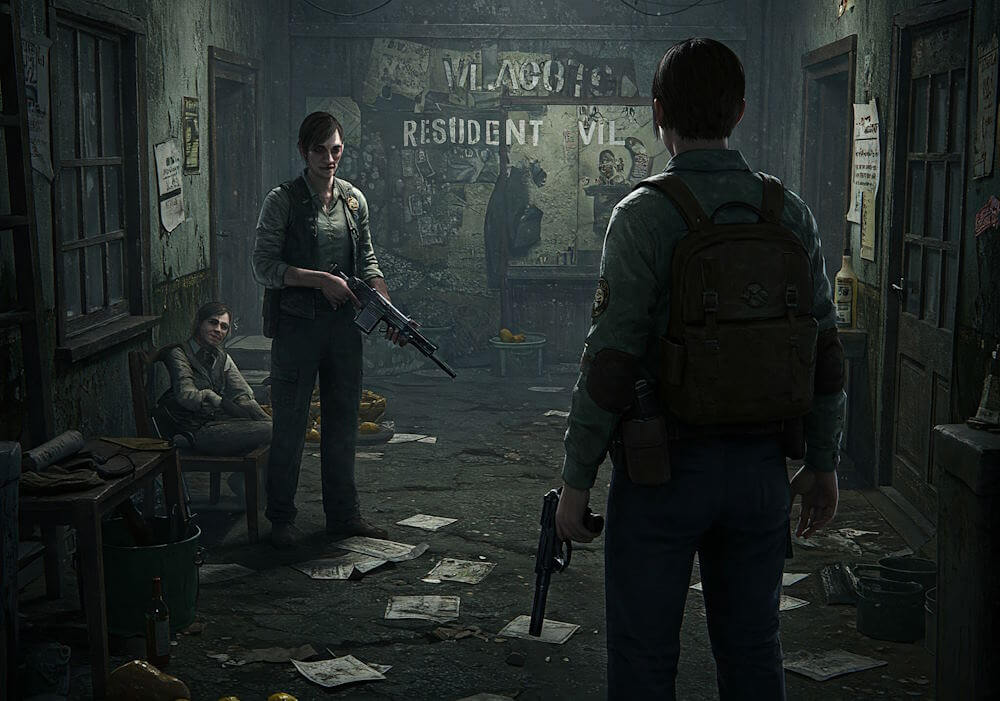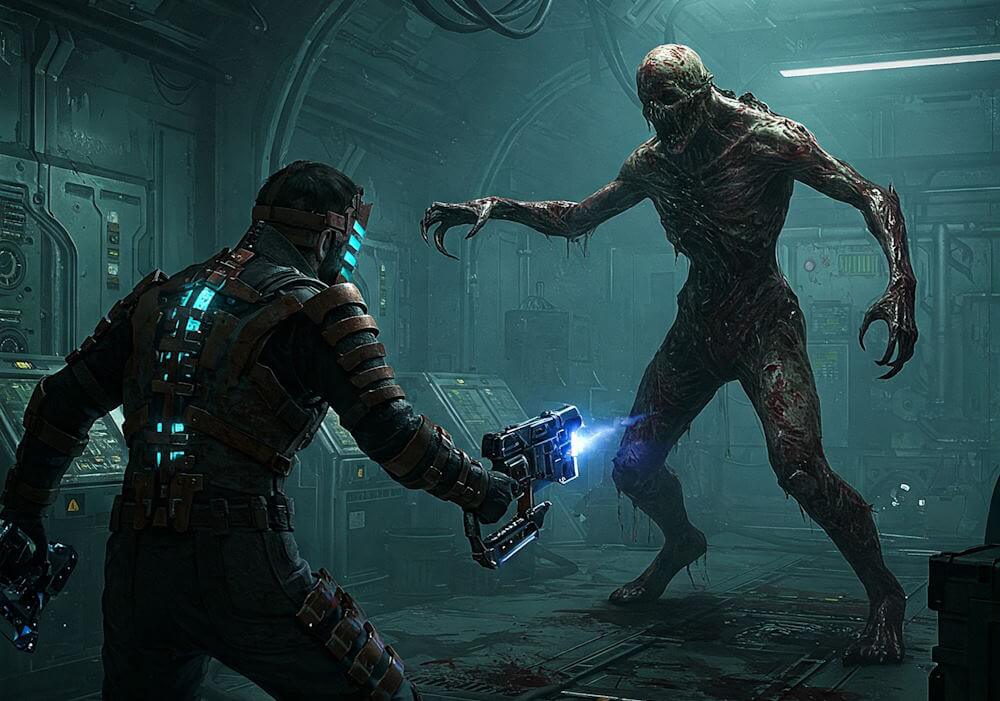The launch of Resident Evil Village VR marks a significant milestone in the formidable Resident Evil franchise. Initially released in May 2021, Resident Evil Village quickly garnered critical acclaim for its captivating narrative, engaging gameplay mechanics, and haunting atmosphere. This survival horror game serves as a sequel to Resident Evil 7: Biohazard, continuing the journey of protagonist Ethan Winters as he grapples with terrifying adversaries and a menacing environment. As Capcom extends the franchise into the realm of virtual reality, the upcoming VR adaptation promises an unparalleled depth of immersion previously unattainable in traditional gaming.
The significance of Resident Evil Village VR lies in its ability to elevate players’ experiences by placing them directly in the chilling world of the game. Virtual reality technology, renowned for its capacity to transform gameplay interactions, allows fans to experience horror in a more visceral and immediate manner. The immersive nature of VR can elevate tension and fear, compounds through realistic visuals and interactive elements. With players donning VR headsets, they will navigate the foreboding village, face supernatural foes, and decipher sinister puzzles from a first-person perspective, heightening the thrill of survival.
Anticipation surrounding Resident Evil Village VR has been palpable within the gaming community. As fans await the chance to confront iconic characters such as Lady Dimitrescu and explore the intricate environments, the prospect of experiencing these horrors at an entirely new dimension has sparked excitement. This adaptation not only offers a fresh take on the original game but also reinforces the Resident Evil franchise’s commitment to evolving and pushing boundaries in the horror genre. As we delve deeper into this release, it is evident that Resident Evil Village VR will redefine what it means to face fear in gaming narratives.
The Evolution of Horror Games in VR
The landscape of horror gaming has undergone significant transformation since the inception of virtual reality (VR) technology. Traditional horror games primarily relied on graphical fidelity and atmospheric storytelling to induce fear. With the advent of VR, the horror genre has embraced a new dimension of immersion that magnifies the psychological elements of fear, tension, and suspense. The ability to physically interact with virtual environments enables players to engage with fear in a profoundly personal manner, making horror experiences much more intense.
As the VR technology evolved, developers began to explore more innovative approaches to storytelling within horror games. Pioneering titles like “Resident Evil 7: Biohazard” demonstrated how VR could strategically enhance the horror experience by placing players directly into a nightmarish world. The game’s first-person perspective, combined with realistic graphics and sound design, created an atmosphere conducive to genuine fear, setting a precedent for future VR horror titles. This evolution continues with games such as “Phasmophobia” and “The Walking Dead: Saints & Sinners,” which have pushed the boundaries by integrating multiplayer elements and detailed environmental mechanics.
Notably, the use of audio cues, physical movements, and spatial awareness in VR elevates horror gameplay to unprecedented levels. Players navigating dark corridors or encountering grotesque creatures gain a visceral understanding of their fearful surroundings, leading to heightened emotional responses. Developers have leveraged this reality to craft horror experiences that exploit both the known fear of the unknown and the immediacy of virtual threats. As the industry progresses, the potential for horror games in VR appears limitless, promising to redefine the genre for years to come.
Through advancements in hardware and software, VR horror games have shown a remarkable capacity to engage players, encouraging developers to continually innovate and expand on the classic horror formulas. The evolution of horror in VR signifies a compelling future for both players and developers in this captivating genre.
Enhanced Graphics and Realism in VR
In the realm of virtual reality (VR), graphical enhancements play a pivotal role in shaping the gaming experience, particularly in a title like Resident Evil Village. The transfer of this horror survival game into a VR environment significantly amplifies its immersive qualities, thanks to an uptick in visual fidelity. Enhanced graphics create a more lifelike portrayal of the game’s characters, environments, and the various horrific elements that players encounter, serving to intensify the game’s overall frightening atmosphere.
The character designs in Resident Evil Village VR demonstrate remarkable detail, with closely rendered facial expressions and realistic animations that contribute to a palpable sense of presence. This intricate attention to detail allows players to engage with characters on a more emotional level, affecting their reactions during key moments of the narrative. Furthermore, environmental graphics have undergone substantial improvements, allowing for richer textures and a heightened sense of depth. Whether navigating through dimly lit corridors or exploring expansive outdoor settings, gamers are fully enveloped in the eerie world of Resident Evil.
Moreover, the introduction of advanced lighting techniques in VR not only enhances visual realism but also adds to the game’s suspenseful atmosphere. Dynamic shadows and ambient light sources contribute to a convincing sense of realism, making players feel as though they are genuinely part of the game’s terrifying landscape. Sound design, when paired with these visual enhancements, complements the overall experience; creaking doors, distant howls, and sudden noises draw players deeper into an adrenaline-pumping adventure.
Overall, the amalgamation of superior graphics and immersive soundscapes in Resident Evil Village VR results in a terrifyingly engaging experience that is difficult to replicate in traditional formats. As players face their fears in this intricate virtual world, the enhanced realism sets a new standard for horror gaming, taking tension and engagement to unprecedented heights.
Immersive Gameplay Mechanics
The introduction of virtual reality (VR) in Resident Evil Village transforms the gaming experience considerably, primarily through unique gameplay mechanics that immerse players in an unparalleled horror environment. One of the most significant changes is the transition to a first-person perspective. Unlike traditional gameplay, which often provides an overhead or third-person view, the first-person perspective in VR offers a far more intimate experience. Players are placed directly into the shoes of the protagonist, fully experiencing the chilling atmosphere and engaging with the game world from a personal vantage point.
Another crucial aspect of the immersive gameplay mechanics is spatial audio. In VR, sounds are not only heard but localised. This technology allows players to understand the direction of approaching threats and creates an all-encompassing soundscape that immerses them deeper into the terrifying scenarios presented within the game. The ability to hear the faintest rustle of leaves or the distant growl of enemies enhances the horror elements, making every sound feel significant and potentially life-threatening.
Moreover, physical interactions with the game environment serve to heighten the sense of presence. Players can manipulate objects, open doors, and engage with various elements of the setting using their own physical actions, rather than relying solely on button prompts or controller input. This tactile feedback blends seamlessly with the horror atmosphere, making seemingly mundane actions feel fraught with tension. VR enhances emotional responses by forcing players to confront their fears in ways that traditional gaming does not, resulting in an escalating scare factor throughout the experience.
In the captivating world of Resident Evil Village VR, these immersive gameplay mechanics work cohesively, ensuring players not only encounter fear but fully inhabit it. As technology continues to advance, the potential for even richer experiences in horror gaming will undoubtedly deepen, leaving players at the edge of their seats.
Character Interactions and Storytelling
In Resident Evil Village, the integration of virtual reality (VR) fundamentally transforms the player experience, particularly through enhanced character interactions and storytelling. The immersive nature of VR allows players to engage with the game’s environment and non-player characters (NPCs) in a more intimate and personal way. When donning a VR headset, players are not merely observers; they become active participants in the unfolding narrative. This heightened level of interaction significantly amplifies the emotional weight of the story.
One of the most notable enhancements is the ability to physically move within the game world. This enables players to interact with NPCs through gestures, gaze, and proximity, creating a sense of realism that traditional gameplay lacks. For instance, players can lean in to hear a character’s whispered secrets or back away in fear during tense moments. Such dynamics contribute to a more profound sense of connection between the player and the NPCs, thereby fostering an emotional investment in the storyline. The dialogue is also enriched by this proximity; listening closely to character exchanges and observing facial expressions in real-time adds depth to the character development and plot progression.
Furthermore, VR offers a unique perspective on plot elements, allowing players to experience key events from angles that would typically be unavailable in standard gameplay. By navigating the environment in three dimensions, players can discover hidden details and clues that enhance their understanding of the narrative. This exploration not only intensifies the feeling of dread common in the Resident Evil franchise but also supports a more intricate exploration of character backstories. Each interaction reveals layers of lore and motivation that contribute to the overarching anxiety and terror that permeate the game.
Ultimately, the character interactions and storytelling within Resident Evil Village are significantly enhanced through VR technology. As players navigate the chilling atmosphere of the village, every encounter becomes an opportunity to delve deeper into a haunting narrative, making the experience not just scarier but also profoundly engaging.
The Role of Sound Design in VR Horror
In the landscape of virtual reality (VR) gaming, sound design serves as a pivotal element, significantly enhancing the horror experience. In games such as Resident Evil Village VR, sound design is not merely an accessory; it becomes an immersive tool that dictates the emotional response of the player. The intricacies of the audio elements work in conjunction with the visual components to elevate the level of tension and anxiety that defines the horror genre.
One of the most effective methods employed in Resident Evil Village VR is spatial audio. This technology simulates three-dimensional soundscapes, allowing players to discern the direction and distance of sounds. As players navigate the eerie corridors and ominous environments of the village, every creak, whisper, and distant growl can be perceived with uncanny precision. This audio realism engenders an unsettling atmosphere, immersing players deeper into the chilling world, thus amplifying the overall horror experience.
The intelligent layering of ambient sound also contributes significantly to the game’s foreboding nature. Subtle, low-frequency sounds—such as distant thunder or the rustling of trees—create an undercurrent of unease that keeps players on edge. These audio cues are strategically placed to elicit a psychological response, as players are conditioned to associate particular sounds with impending danger. Moreover, the use of silence can be just as impactful, as it can create a tense pause that heightens the players’ anticipation and anxiety before a sudden audio explosion occurs.
Furthermore, character sound design, including distinctive vocalizations and the sounds of movement, enhances the sense of realism. Each enemy has a unique auditory signature that warns players of their presence, serving as an effective mechanism to induce fear and suspense. Consequently, the meticulous craft of sound design in Resident Evil Village VR is fundamental in shaping the players’ immersive experience, transforming it into a haunting adventure that lingers long after the headset is removed.
Psychological Impact of VR Horror
The advent of virtual reality (VR) technology has transformed the gaming landscape, particularly within the horror genre. One of the most striking aspects of VR horror experiences, such as Resident Evil Village VR, is their profound psychological impact on players. The immersive nature of VR transports individuals into a meticulously crafted environment that amplifies feelings of anxiety, fear, and adrenaline, creating a deeply engaging yet unsettling experience.
When players don a VR headset, their senses are fully engaged, leading to a heightened sense of presence in the virtual world. This can result in more intense emotional reactions compared to traditional gaming. In Resident Evil Village VR, players are not merely observers; they become active participants in the horror narrative. As players navigate through the eerie landscapes filled with unexpected threats, their bodies often respond with physiological changes commonly associated with fear, such as increased heart rate and elevated adrenaline levels. The psychological immersion provided by VR allows for a unique blending of reality and fantasy, making every jump scare and unsettling encounter feel strikingly real.
Moreover, the psychological effects of VR horror can extend beyond momentary fear. Some players may experience lingering anxiety even after the VR session concludes, reflecting the powerful nature of immersive storytelling in games like Resident Evil Village VR. This phenomenon raises questions about the potential implications of frequent exposure to such intense experiences on mental well-being. While many players relish the thrill of facing fears in a controlled environment, it’s essential to recognize that this can also provoke feelings of stress and dread, particularly for more sensitive individuals.
As technology continues to evolve and VR gaming becomes increasingly sophisticated, understanding the psychological impact of such immersive experiences is vital. Resident Evil Village VR exemplifies the genre’s capacity to evoke powerful emotional responses, ultimately pushing the boundaries of interactive entertainment and leaving a lasting impression on its players.
Community Reception and Player Feedback
The release of Resident Evil Village VR has elicited a wealth of responses from the gaming community, with players sharing their experiences across forums and social media platforms. The initial reception suggests that fans of the franchise are largely enthusiastic about the immersive elements that virtual reality brings to the survival horror genre. Many players have praised the game’s ability to translate the tension and atmosphere of the original Village experience into a VR setting, creating a more intense and personal engagement with the storyline and its characters.
Numerous reviews highlight the improved sense of scale and presence that VR fosters, allowing players to feel physically in the eerie environments the game showcases. The level of detail in the graphics and audio has also received positive feedback, as users report that the 3D sound design enhances the fear factor, making the unexpected moments even more startling. The physicality of VR mechanics, such as using motion controls for actions like reloading weapons, has also been noted as a significant improvement, allowing for a more genuine involvement in gameplay.
However, along with the commendations, there are critiques that players have articulated. Some users have expressed concerns regarding motion sickness, a common issue in VR gaming that can detract from the overall experience. Additionally, certain players have pointed out that the comfort settings could be inadequate for newcomers to VR, suggesting that adjustments may be necessary to accommodate a broader audience. Another point of contention is the availability of content; while the game is new, players are eager for additional updates or downloadable content that could expand their experience.
Overall, community feedback on Resident Evil Village VR presents a balanced view, demonstrating a mix of excitement and thoughtful criticism. This valuable input may guide developers in refining future iterations and potential expansions within the virtual reality landscape of horror gaming.
Conclusion: The Future of Resident Evil VR Games
Resident Evil Village VR represents a significant advancement in the integration of virtual reality within the renowned Resident Evil franchise. This latest installment not only enhances the immersive experience for players but also redefines the expectations for horror gaming. Through its innovative use of VR technology, the game allows players to feel the acute tension and fear characteristic of the series like never before. Key elements such as realistic graphics and finely tuned gameplay mechanics accentuate the chilling ambiance, making each encounter both exhilarating and terrifying.
As we look ahead, the future of Resident Evil VR games appears promising. The immersive potential of virtual reality opens the door for a plethora of possibilities. Capcom may explore the narratives of previous titles, reimagining them for the VR platform, or they might introduce entirely new storylines set within the Resident Evil universe. This approach could not only breathe new life into well-loved characters but also attract a broader audience who seek unparalleled immersion offered by VR technology.
Moreover, potential sequels or expansions following the success of Resident Evil Village VR could leverage lessons learned from previous releases. By refining gameplay mechanics and expanding on popular elements, future titles may further enhance player engagement. With the recent advancements in VR technology, one can expect the upcoming Resident Evil VR experiences to push the boundaries of what is currently possible, amplifying both the horror and excitement factors inherent in the franchise.
In conclusion, as virtual reality continues to evolve, it holds the key to unlocking new dimensions in horror gaming, particularly within beloved franchises like Resident Evil. The fusion of innovative gameplay and the overwhelming immersion provided by VR ensures that players can anticipate thrilling and terrifying experiences well into the future.




